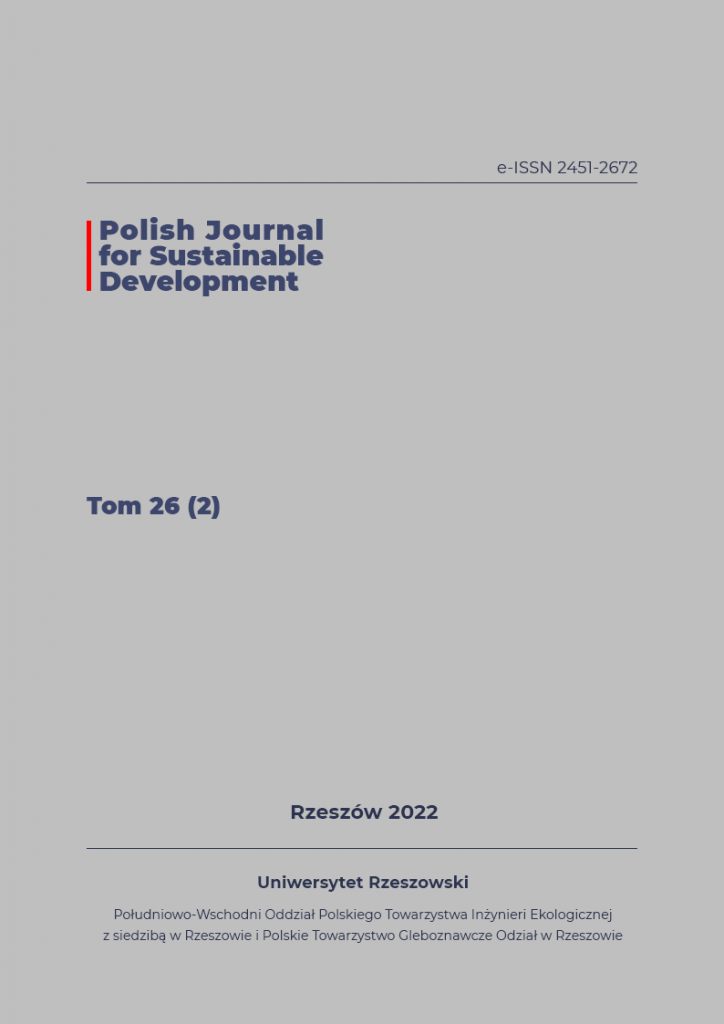Obiekty dystrybucji paliw – HRS
DOI:
https://doi.org/10.15584/pjsd.2022.26.2.3Słowa kluczowe:
obiekty dystrybucji paliw, wodór, dekarbonizacja, zrównoważony rozwój transportu, stacja tankowania wodoru, HRS, tankowanie pojazdówAbstrakt
Strategia Komisji Europejskiej w osiągnięciu neutralności klimatycznej do 2050 r., wpłynie na zmniejszenie zużycia paliw kopalnych oraz poprawę jakości powietrza, zwłaszcza w miastach. Jednym ze sposobów osiągania tego celu jest dekarbonizacja gospodarki, w tym sektora transportu, który jest kluczowym dla przedsiębiorstw w globalnych łańcuchach dostaw. Eksperci uważają, że wodór zero i nisko emisyjny stosowany w pojazdach elektrycznych z wodorowymi ogniwami paliwowymi jest kluczem w realizacji tego wyzwania, w transporcie osobowym i ciężkim (ang. heavy duty) obejmującym transport lądowy, morski oraz powietrzny. Jednak, żeby wodór stał się paliwem powszechnie używanym w transporcie, konieczny jest rozwój niezbędnej infrastruktury i właściwe regulacje prawne. W pracy przedstawiono genezę powstawania obiektów dystrybucji paliwa wodorowego – HRS, kluczowe aspekty jego wprowadzania na świecie, w Europie oraz w Polsce. Przeanalizowano dane koncernów zajmujących się dystrybucją tego rodzaju paliwa, które chcą osiągnąć neutralność klimatyczną, a jednocześnie muszą zapewnić paliwa transportowe dla odbiorców. Stwierdzono, że transformacja energetyczna oraz rodzaj stosowanych nośników energii i paliw silnikowych napędzających pojazdy samochodowe, wymagają zmiany i ewolucji obiektów dystrybucji paliw.
Downloads
Bibliografia
Alternative Fuels Data Center (AFDC) 2022. Department of Energy. [dok. Elektr. www.afdc.energy.gov/fuels/hydrogen.html; data wejścia 03.10.2022].
Dyrektywa Parlamentu Europejskiego i Rady 2014/94/UE z 22.10.2014 r. w sprawie rozwoju infrastruktury paliw alternatywnych [Dz. Urz. UE L 307 z 28.10.2014].
Ehrhart B., Bran-Anleu G., Dongmei Ye, Hecht E., Muna A., Sena E., LaFleur C., Rivkin C. 2019a. Reference Design of Hydrogen Stations for Urban Sites, Presentation at Joint Hydrogen Delivery, Codes & Standards, and Storage Tech Team Meeting. March 13. SAND2019-2734PE.
Ehrhart B., Bran-Anleu G., Dongmei Ye, Hecht E., Muna A., Sena E., LaFleur C., Rivkin C. 2019b. Hydrogen Stations for Urban Sites, Presentation at 2019 DOE Hydrogen and Fuel Cells, Program Annual Merit Review and Peer Evaluation Meeting. May 1. SAND2019-2422PE.
European Academies Science Advisory Council (EASAC). 2019. Decarbonization of transport options and challenges. Decarbonization of transport: options and challenges. EASAC policy report 37. March. ISBN: 978-3-8047-3977-2.
European Union Hydrogen Highway (EUHH) 2022. [dok. Elektr. http://www.hydrogencaronow.com/eu-hydrogenhighway.html; data wejścia 03.10.2022].
Fuel Cells and Hydrogen – joint undertaking June 2021. Hydrogen refuelling stations & infrastructure. [dok. elektr. https://hyresponder.eu/wp-content/uploads/2021/06/L12_HyResponder_L4_210622.pdf; data wejścia 03.10.2022].
Fuel Cells Works (FCW). 2021. Worldwide Sales Of Hydrogen Fuel Cell Cars Double from Last Year. [dok. elektr. https://fuelcellsworks.com/news/worldwide-sales-of-hydrogen-fuel-cell-cars-double from-last-year/; data wejścia 03.10.2022].
Gis M. 2018. Emisja dwutlenku węgla z transportu drogowego – cz. 2 samochody klasy hdv. Instytut Transportu Samochodowego. Transport Samochodowy 1-2018.
Hamelinck C., Spöttle M., Mark L., Staats M. 2019. Możliwości dekarbonizacji transportu do 2030 roku. Ecofys 2019 na zlecenie: Farm Europe. [dok. elektr. https://www.europarl.europa.eu/news/pl/headlines/society/20190313STO31218/emisje-co2-z-samochodow-fakty-i-liczby-infografiki; data wejścia 03.10.2022].
H2 Stations Map 2022. Ludwig-Bölkow-Systemtechnik GmbH. [dok. Elektr. https://www.h2stations.org/stations-map/; data wejścia 03.10.2022].
H2 tanken. 2022. Wasserstoffmobilität beginnt jetzt. [dok. elektr. https://h2.live/; data wejścia 03.10.2022].
International Energy Agency (IEA). 2017a. Future of Trucks.
International Energy Agency (IEA). 2017b. Energy Technology Perspectives. Deloitte Analysis.
International Energy Agency (IEA). 2020a. CO 2 emission by sector, World 1990-2018.
International Energy Agency (IEA). 2020b. CO 2 emission 1) industry, 2) transport and 3) heavy duty vehicles in sustainable development scenario 2000-2030. Deloitte Analysis.
International Energy Agency (IEA). 2020c. Transport sector CO 2 emissions by mode.
International Energy Agency (IEA). 2020d. Tracking Transport. Deloitte analysis.
International Energy Agency (IEA). 2020e. Energy Technology Perspectives.
International Energy Agency (IEA). 2022. Global EV Outlook 2022 Securing supplies for an electric future. [dok. elektr. https://iea.blob.core.windows.net/assets/e0d2081d-487d-4818-8c59-69b638969f9e/GlobalElectricVehicleOutlook2022.pdf; data wejścia 03.10.2022].
Komisja Europejska 2022a. Wydajny, bezpieczny i przyjazny dla środowiska transport. [dok. elektr https://ec.europa.eu/info/strategy/priorities-2019-2024/european-green-deal/transport-and-green-deal_pl; data wejścia 03.10.2022].
Komisja Europejska 2022b. Dekarbonizacja europejskiego sektora transportu. [dok. Elektr. https://cordis.europa.eu/article/id/436498-decarbonising-europe-s-transport-sector/pl; data wejścia 03.10.2022].
Krajowy Ośrodek Bilansowania i Zliczania Emisji (KOBiZE) 2021. Emisje gazów cieplarnianych i innych zanieczyszczeń w sektorze transportu samochodowego w Polsce – uwarunkowania i możliwości redukcji. IV Forum Innowacyjności. Polska droga do czystego transportu. 05.03.2021 r.
Organization for Economic CO-Operation and Development (OECD) 2020. Road Freight Transport TKM. [dok. elektr. https://data.oecd.org/transport/freight-transport.htm; data wejścia 03.10.2022].
Organization for Economic CO-Operation and Development (OECD) 2019. ITF Transport Outlook.
[dok. Elektr. https://www.oecd-ilibrary.org/transport/itf-transport-outlook-2019_transp_outlook-en-2019-en; data wejścia 03.10.2022].
Parlament Europejski 2022. Emisje CO 2 z samochodów: fakty i liczby (infografiki). [dok.
Elektr. https://www.europarl.europa.eu/news/pl/headlines/society/20190313STO31218/emisje-co2-z-samochodow-fakty-i-liczby-infografiki; data wejścia 03.10.2022].
Polski Związek Przemysłu Motoryzacyjnego (PZPM) 2022. [dok. Elektr. https://www.pzpm.org.pl/pl/Rynek-motoryzacyjny/Licznik-elektromobilnosci/Marzec-2022; data wejścia 03.10.2022].
Rabiega W. P., Sikora P. 2020. Ścieżki redukcji emisji CO 2 w sektorze transportu w Polsce w kontekście „europejskiego zielonego ładu”. Instytut Ochrony Środowiska – Państwowy Instytut Badawczy (IOŚ-PIB). Warszawa październik 2020 r.
Rozporządzenie Ministra Klimatu i Środowiska z dnia 7 października 2022 r. w sprawie szczegółowych wymagań technicznych dla stacji wodoru (Dz.U. 2022 poz. 2158).
Samsun R., Antoni L., Rex M., Stolten D. 2021. Deployment Status of Fuel Cells in Road Transport: 2021 Update. Energie & Umwelt /Energy & Environment Band/Volume 542 ISBN 978-3-95806-556-7.
Sen A., Miller J. 2022. Emissions reduction benefits of a faster, global transition to zero-emission vehicles. Working Paper 2022-15. ICCT International Council on Clean Transportation. [dok. elektr. https://theicct.org/wp-content/uploads/2022/03/Accelerated-ZEV-transition-wp-final.pdf; data wejścia 03.10.2022].
Statista 2022. Number of hydrogen-fueled road vehicles worldwide as of 2020, by type. [dok. elektr. https://www.statista.com/statistics/1291480/hydrogen-fueled-road-vehicles-worldwide/; data wejścia 03.10.2022].
United Nations Framework Convention on Climate Change (UNFCCC) 2020. Race To Zero. [dok. elektr. https://unfccc.int/climate-action/race-to-zerocampaign; data wejścia 03.10.2022].
Ustawa z dnia 11 stycznia 2018 r. o elektromobilności i paliwach alternatywnych [t.j. Dz.U. 2022 poz. 1083, ze zm.].
Pobrania
Opublikowane
Numer
Dział
Licencja
Prawa autorskie (c) 2022 Polish Journal for Sustainable Development

Utwór dostępny jest na licencji Creative Commons Uznanie autorstwa – Użycie niekomercyjne – Bez utworów zależnych 4.0 Międzynarodowe.


